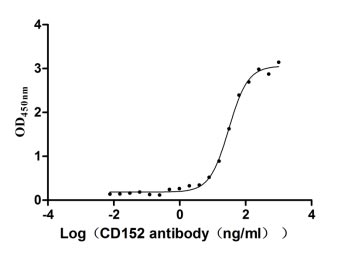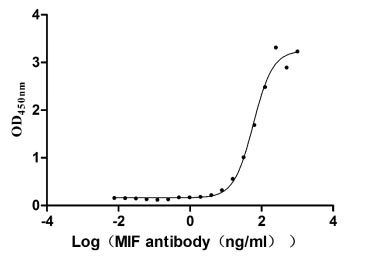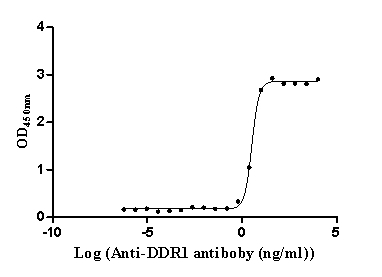Recombinant Mouse Glutamine synthetase (Glul)
-
货号:CSB-YP009553MO
-
规格:
-
来源:Yeast
-
其他:
-
货号:CSB-EP009553MO
-
规格:
-
来源:E.coli
-
其他:
-
货号:CSB-EP009553MO-B
-
规格:
-
来源:E.coli
-
共轭:Avi-tag Biotinylated
E. coli biotin ligase (BirA) is highly specific in covalently attaching biotin to the 15 amino acid AviTag peptide. This recombinant protein was biotinylated in vivo by AviTag-BirA technology, which method is BriA catalyzes amide linkage between the biotin and the specific lysine of the AviTag.
-
其他:
-
货号:CSB-BP009553MO
-
规格:
-
来源:Baculovirus
-
其他:
-
货号:CSB-MP009553MO
-
规格:
-
来源:Mammalian cell
-
其他:
产品详情
-
纯度:>85% (SDS-PAGE)
-
基因名:
-
Uniprot No.:
-
别名:Glul; Glns; Glutamine synthetase; GS; EC 6.3.1.2; Glutamate--ammonia ligase; Palmitoyltransferase GLUL; EC 2.3.1.225
-
种属:Mus musculus (Mouse)
-
蛋白长度:Full Length of Mature Protein
-
表达区域:2-373
-
氨基酸序列ATSASSHLN KGIKQMYMSL PQGEKVQAMY IWVDGTGEGL RCKTRTLDCE PKCVEELPEW NFDGSSTFQS EGSNSDMYLH PVAMFRDPFR KDPNKLVLCE VFKYNRKPAE TNLRHICKRI MDMVSNQHPW FGMEQEYTLM GTDGHPFGWP SNGFPGPQGP YYCGVGADKA YGRDIVEAHY RACLYAGVKI TGTNAEVMPA QWEFQIGPCE GIRMGDHLWI ARFILHRVCE DFGVIATFDP KPIPGNWNGA GCHTNFSTKA MREENGLKCI EEAIDKLSKR HQYHIRAYDP KGGLDNARRL TGFHETSNIN DFSAGVANRG ASIRIPRTVG QEKKGYFEDR RPSANCDPYA VTEAIVRTCL LNETGDEPFQ YKN
-
蛋白标签:Tag type will be determined during the manufacturing process.
The tag type will be determined during production process. If you have specified tag type, please tell us and we will develop the specified tag preferentially. -
产品提供形式:Lyophilized powder
Note: We will preferentially ship the format that we have in stock, however, if you have any special requirement for the format, please remark your requirement when placing the order, we will prepare according to your demand. -
复溶:We recommend that this vial be briefly centrifuged prior to opening to bring the contents to the bottom. Please reconstitute protein in deionized sterile water to a concentration of 0.1-1.0 mg/mL.We recommend to add 5-50% of glycerol (final concentration) and aliquot for long-term storage at -20℃/-80℃. Our default final concentration of glycerol is 50%. Customers could use it as reference.
-
储存条件:Store at -20°C/-80°C upon receipt, aliquoting is necessary for mutiple use. Avoid repeated freeze-thaw cycles.
-
保质期:The shelf life is related to many factors, storage state, buffer ingredients, storage temperature and the stability of the protein itself.
Generally, the shelf life of liquid form is 6 months at -20°C/-80°C. The shelf life of lyophilized form is 12 months at -20°C/-80°C. -
货期:Delivery time may differ from different purchasing way or location, please kindly consult your local distributors for specific delivery time.Note: All of our proteins are default shipped with normal blue ice packs, if you request to ship with dry ice, please communicate with us in advance and extra fees will be charged.
-
注意事项:Repeated freezing and thawing is not recommended. Store working aliquots at 4°C for up to one week.
-
Datasheet :Please contact us to get it.
靶点详情
-
功能:Glutamine synthetase that catalyzes the ATP-dependent conversion of glutamate and ammonia to glutamine. Its role depends on tissue localization: in the brain, it regulates the levels of toxic ammonia and converts neurotoxic glutamate to harmless glutamine, whereas in the liver, it is one of the enzymes responsible for the removal of ammonia. Essential for proliferation of fetal skin fibroblasts. Independently of its glutamine synthetase activity, required for endothelial cell migration during vascular development. Involved in angiogenesis by regulating membrane localization and activation of the GTPase RHOJ, possibly by promoting RHOJ palmitoylation. May act as a palmitoyltransferase for RHOJ: able to autopalmitoylate and then transfer the palmitoyl group to RHOJ. Plays a role in ribosomal 40S subunit biogenesis.
-
基因功能参考文献:
- genetic deletion of Glul in endothelial cells impairs vessel sprouting during vascular development, whereas pharmacological blockade of glutamine synthetase suppresses angiogenesis in ocular and inflammatory skin disease while only minimally affecting healthy adult quiescent endothelial cells PMID: 30158707
- The data identify GS activity as mediator of the proangiogenic, immunosuppressive, and pro-metastatic function of M2-like macrophages and highlight the possibility of targeting this enzyme in the treatment of cancer metastasis. PMID: 28813676
- Our study highlights a new role of GS in modulating immune response in microglia, providing insights into the pathogenic mechanisms associated with inflammation and new strategies of therapeutic intervention PMID: 27758118
- We conclude that 1) GS-mediated ammonia recycling in the PT contributes to both basal and acidosis-stimulated ammonia metabolism and 2) adaptive changes in other proteins involved in ammonia metabolism occur in response to PT-GS-KO and cause an underestimation of the role of PT GS expression. PMID: 27009341
- Diabetes induces TXNIP expressions at mRNA levels, but shows the opposite effect on GS. PMID: 27131835
- Results indicate that astrocyte glutamine synthase may be the predominant contributor to the pathogenic mechanisms of D-gal-induced brain aging in mice. PMID: 25128847
- Hepatic deletion of GS triggered systemic hyperammonemia, which was associated with cerebral oxidative stress as indicated by increased levels of oxidized RNA and enhanced protein Tyr nitration. PMID: 25870278
- modulation of intracellular glutamine levels by GS expression represents an endogenous mechanism through which mature adipocytes control the inflammatory response PMID: 25451225
- GABABR2 has a role as a regulator of glutamine synthetase stability PMID: 25172509
- the capacity for ammonia disposal correlated inversely with the expression of glutamine synthetase in muscle PMID: 25074987
- Glutamine synthetase in astrocytes from entorhinal cortex of the triple transgenic animal model of Alzheimer's disease is not affected by pathological disease progression. PMID: 23990215
- In a transgenic mouse model of Alzheimer disease, found decrease in number of GS-positive astrocytes in prefrontal cortex from early to middle ages when compared with control animals. PMID: 24059854
- Renal glutamine synthetase is expressed in type A intercalated cells, non-A, non-B intercalated cells, and distal convoluted tubule cells, but not in principal cells, type B intercalated cells, or connecting segment cells. PMID: 23804452
- Methionine sulfoximine target glutamine synthetase is required for the early steps of the cytokine response to endotoxins, and that its pharmacological inhibition may be exploited to treat inflammation. PMID: 21745296
- BDNF can up-regulate GLAST and GS and increase glutamate uptake during hypoxia, and these functions may underlie its neuroprotective effects. PMID: 21448920
- Glutamine synthetase deficiency in murine astrocytes results in neonatal death. PMID: 20140959
- Glutamine synthetase in muscle is required for glutamine production during fasting and extrahepatic ammonia detoxification PMID: 20064933
- Reduction of GS in TGF-beta1-on-mice results from apoptosis of GS-positive hepatocytes rather than downregulation of GS expression PMID: 15246211
- aspartate aminotransferase and glutamine synthetase have roles in glucocorticoid activation in mouse Schwann cells PMID: 16182522
- There was a >100-fold difference in GS mRNA, protein, and enzyme-activity levels among organs, whereas there was only a 20-fold difference in the GS protein:mRNA ratio, suggesting extensive transcriptional and posttranscriptional regulation. PMID: 16609703
- oestradiol induced expression of GS suggests a significant role for glial cells in hormonal modulation of glutamatergic neurotransmission important to female reproductive behaviours, neuroendocrine physiology and cognitive functions PMID: 16879168
- In myocytes and hepatomas, but not in adipocytes, glutamine acts to moderate glutamine synthetase induction by glucocorticoids. PMID: 17197094
- In H4Flox liver, glutamine synthetase (GS), ornithine aminotransferase (OAT) and thyroid hormone-receptor beta1 (TRbeta1) were exclusively expressed in pericentral hepatocytes. PMID: 17256722
- Our results indicate that individuals with reduced glutamine synthetase activity may have reduced FS seizure thresholds. Genetic association studies will be required to test this hypothesis. PMID: 19170755
显示更多
收起更多
-
亚细胞定位:Cytoplasm, cytosol. Microsome. Mitochondrion. Cell membrane; Lipid-anchor.
-
蛋白家族:Glutamine synthetase family
-
组织特异性:Expressed in microvascular endothelial cells.
-
数据库链接:
KEGG: mmu:14645
STRING: 10090.ENSMUSP00000083375
UniGene: Mm.210745
Most popular with customers
-
Recombinant Human Cytotoxic T-lymphocyte protein 4 (CTLA4), partial (Active)
Express system: Mammalian cell
Species: Homo sapiens (Human)
-
Recombinant Human Programmed cell death protein 1 (PDCD1), partial (Active)
Express system: Mammalian cell
Species: Homo sapiens (Human)
-
Recombinant Human Macrophage migration inhibitory factor (MIF) (Active)
Express system: Mammalian cell
Species: Homo sapiens (Human)
-
Recombinant Human Epithelial discoidin domain-containing receptor 1 (DDR1), partial (Active)
Express system: Mammalian cell
Species: Homo sapiens (Human)
-
Recombinant Macaca fascicularis CD44 antigen (CD44), partial (Active)
Express system: Mammalian cell
Species: Macaca fascicularis (Crab-eating macaque) (Cynomolgus monkey)
-
Recombinant Human Microtubule-associated protein tau (MAPT) (Active)
Express system: Mammalian cell
Species: Homo sapiens (Human)
-
Recombinant Human Complement component C1q receptor (CD93), partial (Active)
Express system: Mammalian cell
Species: Homo sapiens (Human)
-
Recombinant Human Alkaline phosphatase, germ cell type (ALPG) (Active)
Express system: Mammalian cell
Species: Homo sapiens (Human)







-AC1.jpg)












